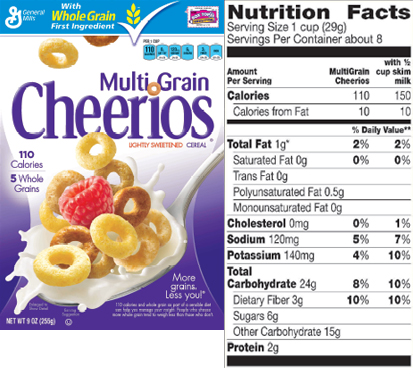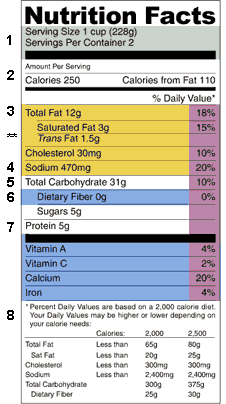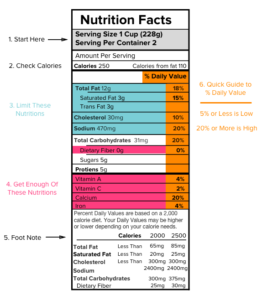39 understanding fat on nutrition labels
Understanding and Using the Nutrition Facts Label fat-free or 1% low-fat dairy products, eggs, lean meats packaged foods, snacks, and condiments. Limit baked and poultry, seafood, soy products, nuts, and seeds. Understanding Nutritional Labels | Beaumont | Beaumont Health Here are the parts of most food labels: Calories (total calories and calories from fat) - This part of the label tells you how many calories each serving has and how many of those calories come from fat. Total Fat - Total fat is the number of fat grams per serving. There are different types of fat. Some are good for you and some aren't.
How to understand food labels | Eat For Health Sometimes labels will include nutrition content claims like 'low fat', 'reduced salt' or 'high fibre'. These claims can only be used if the food meets certain criteria. For example, with a 'good source of calcium' claim, the food must contain more than a set amount of calcium. While nutrition content claims can generally guide ...

Understanding fat on nutrition labels
Food labels 101: Understanding the nutrition facts panel The guideline is that five percent or less is low in a nutrient and 20 percent or more is high. For example, if a nutrition facts panel says that the %DV for calcium is 20 percent and iron is four percent, then you know that the food item is high in calcium but low in iron. Note: There is no %DV for sugars, trans fat and protein. 20 Tips for Understanding Nutrition Labels | Eat This Not That Macronutrients include fat, carbs (which also breaks down into fiber and sugar), and protein. If anything stands out to you—like the product having 17 grams of fat or 25 grams of sugar—use those numbers to help you skim the ingredient list. For example, a cereal that has 6 grams of fat in it is odd. How To Read Food and Beverage Labels | National Institute on ... Feb 24, 2022 · Although frozen and canned fruits and vegetables have food labels, fresh varieties often do not. You can find nutrition information for fresh vegetables and fruits on the USDA website. Or you can call the U.S. Department of Agriculture’s Food and Nutrition Information Center at 301-504-5414. Understanding percent Daily Value (% DV)
Understanding fat on nutrition labels. Understanding Nutrition Labels - Facty Health Know Your Fats Not all fats are the same. Unsaturated fat is essential for the normal functioning of the body, but saturated fats can negatively impact health and should be limited. A nutritional label lists saturated fat separately, so this is the value to pay attention to. You'll also see a line for cholesterol. Fat - British Nutrition Foundation Fat provides essential fatty acids and carries fat-soluble vitamins. High-fat foods contain a lot of calories. Replacing saturated with unsaturated fats in the diet can help reduce our blood cholesterol. High blood cholesterol is a risk factor for heart disease and stroke. Understanding Food Labels | The Nutrition Source | Harvard T.H. Chan ... For example, a bag of potato chips may advertise that it has 40% less fat and is cholesterol-free, suggesting it is a "healthy" food, when in reality even a "healthier" potato chip is still a high-calorie ultra-processed food offering little nutrition. Some terms are not yet regulated by the FDA such as " natural " or "multigrain." 10 tips for understanding food labels - Heart Matters magazine 10 tips for understanding food labels ; Low fat means: 3g or less per 100g ; High fat means: 17.5g or more per 100g ; Low saturated fat means: 1.5g or less per ...
How to understand food nutrition labels | by Alpha Medical Team | Alpha ... The FDA recommends limiting saturated fat, sodium, and added sugars. On the other hand, it's good to get foods that are high in fiber, vitamin D, calcium, iron, and potassium, as these are some... Food Labels: Fat & Cholesterol | Home & Garden Information Center The Nutrition Facts label shows you how much fat is in a product, even if the fat is hidden as an ingredient. The serving size and the nutrients listed on this label are consistent, which makes it easy to compare similar products without any calculations. % Daily Values (% DVs) are listed in a column on the "Nutrition Facts" label. Understanding Food Nutrition Labels | EmPOWERED To Serve 5 - Understand % Daily Value. The % Daily Value (DV) tells you the percentage of each nutrient in a single serving, in terms of the daily recommended amount. If you want to consume less of a nutrient (such as saturated fat or sodium), choose foods with a lower % DV (5 percent or less). If you want to consume more of a nutrient (such as fiber ... Understanding Nutrition Fact Labels | Penn Highlands Healthcare The nutrients you want more of include: dietary fiber, vitamin D, calcium, iron, and potassium. Unlike saturated fat, sodium, and sugar, Americans generally do not consume enough of these nutrients. Fiber can decrease constipation, lower blood glucose levels and cholesterol levels, while also reducing your caloric intake.
Understanding and Using the Nutrition Facts Label Servings Per Container 1 Amount Per Serving Calories 300 Calories from Fat 45 Daily Value* Total Fat 5g 8% Saturated Fat 1.5g 8% Trans Fat 0g Cholesterol 30mg 10% Sodium 430mg 18% Total Carbohydrate 55g 18% Dietary Fiber 6g 24% Sugars 23g Protein 14g Vitamin A 80% Vitamin C 35% Calcium 6% Food labels - NHS Nutrition labels can help you choose between products and keep a check on the amount of foods you're eating that are high in fat, salt and added sugars. Reading Food Labels | ADA - American Diabetes Association The Nutrition Facts labels on foods are really the key to making the best choices. We'll cover the basics so that these labels make shopping easier for you. Get started. Understanding Carbs. You've heard it all. From carb-free to low-carb, to whole and empty carbs, it's hard to know what it all means. Learn more. How to read food labels: MedlinePlus Medical Encyclopedia Jul 13, 2020 — Food labels give you information about the calories, number of servings, ... Reading the labels can help you make healthy choices when you shop.
Understanding the Nutrition Facts Label - Know Diabetes by Heart Fats Although fat can also contribute to changes in your blood sugar, they have less influence than carbs. However, it is important to reduce amount of saturated and trans fats as a part of a balanced diet. Replacing foods that are high in saturated fat with healthier options can lower blood cholesterol levels and improve lipid profiles. Sodium
Fat Content on Food Labels - Reading Between the Lines The Mayo Foundation continued, "Still, you may be able to tell if a product contains trans fat, even if it's not directly listed on the food label. Look for the words ' hydrogenated ' or 'partially hydrogenated' in the list of ingredients. These terms indicate that the product contains trans fat.
Easy Guide to Understanding Food Labels When You Have ... - MyDoc Choose products low in saturated fat, trans fat and cholesterol. When shopping for food, use the nutrition information panel to compare and choose products with lower fat, saturated fat and cholesterol content. Saturated fat is a type of fat that raises your total and LDL cholesterol and risk of heart disease, so intake should be limited. The ...

Managing Caloric Intake With Food | Nutrition Facts : The Truth Facts About Food, Fruit, Vegetable
Understanding food labels - Canada.ca About nutrients, fats, vitamins on nutrition facts table, on packaged foods. Nutrient content claims Meaning of fat-free, no added sugar, low sodium, other nutrient content claims.
Understanding Food Nutrition Labels | American Stroke Association When the Nutrition Facts label says a food contains "0 g" of trans fat, but includes "partially hydrogenated oil" in the ingredient list, it means the food contains some trans fat, but less than 0.5 grams per serving. So, if you eat more than one serving, you could end up eating too much trans fat.
Understanding Food Nutrition Labels | American Heart Association When the Nutrition Facts label says a food contains "0 g" of trans fat, but includes "partially hydrogenated oil" in the ingredient list, it means the food contains some trans fat, but less than 0.5 grams per serving. So, if you eat more than one serving, you could end up eating too much trans fat.
Learn How the Nutrition Facts Label Can Help You Improve Your Health That means if you consume 2,000 calories in a day, added sugars should account for no more than 200 calories. Read the Nutrition Facts labels on your packaged food and drinks to keep track of sugars, fats, protein, and other nutrients. Most sodium we consume is from salt, and salt is commonly in processed foods.
Reading and Understanding Food Labels and Nutrition Info The number of grams of fat you should eat each day depends on how many calories your body needs and what percent of those calories you want to come from fat. A ...
Food Labels | CDC - Centers for Disease Control and Prevention If you eat the whole thing, you are eating 8 times the amount of calories, carbs, fat, etc., shown on the label. Total Carbohydrate shows you types of carbs in the food, including sugar and fiber. Choose foods with more fiber, vitamins, and minerals. Choose foods with lower calories, saturated fat, sodium, and added sugars. Avoid trans fat.






Post a Comment for "39 understanding fat on nutrition labels"